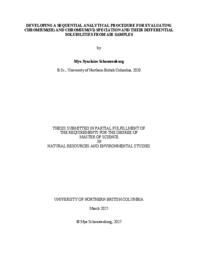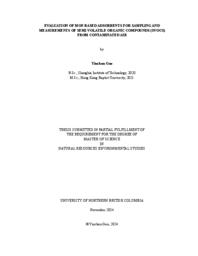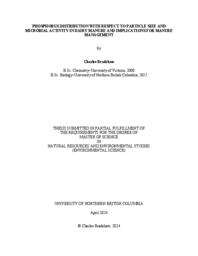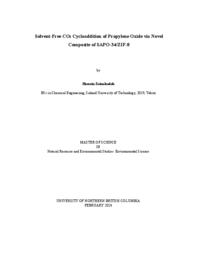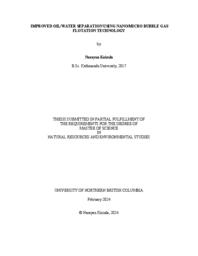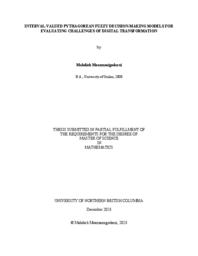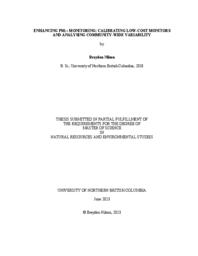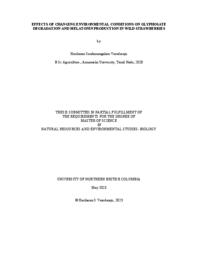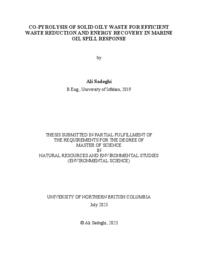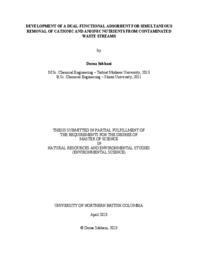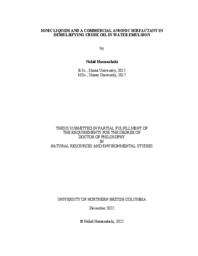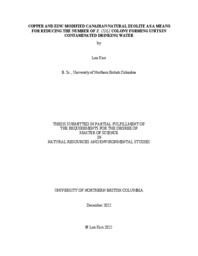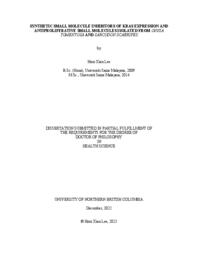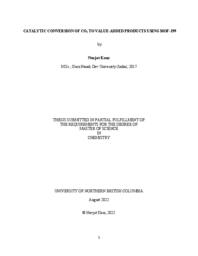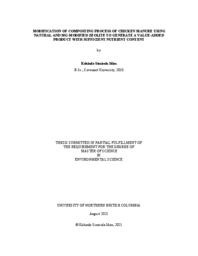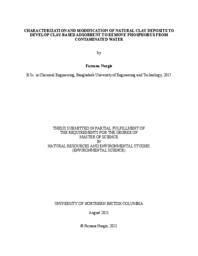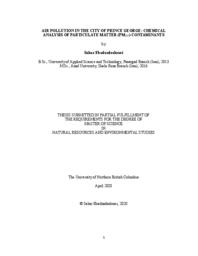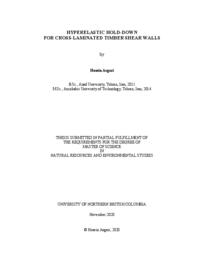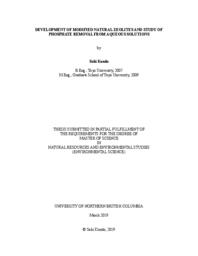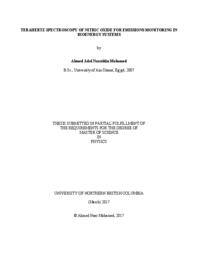Kazemian, Hossein
Person Preferred Name
Hossein Kazemian
Related Works
Content type
Digital Document
Origin Information
Content type
Digital Document
Origin Information
Content type
Digital Document
Origin Information
Content type
Digital Document
Origin Information
Content type
Digital Document
Origin Information
Content type
Digital Document
Description / Synopsis
This work investigated the distribution of phosphorus in dairy manure as it relates to particle size and provides experimentally derived insights for improving the management of phosphorus. The data presented here illustrates some aspects of manure handling that may be optimized for controlling the distribution of phosphorus. It provides experimental data that supplements existing literature by 1) extending the limits of study regarding particle size distribution; 2) extending the limit of centrifugal forces studied; 3) demonstrating an improved pathway for phosphorus management in wastewater using a substrate mediated flocculation process; and 4) providing some experimental observations showing that the microbiota present in dairy manure can diminish stratification of suspended solids and phosphorus concentrations within separated liquid manure products. Further, based on quadratic modeling of phosphorus relative to sieve size, and the observations that accompanied progressive washing and mechanical agitation performed, a convincing argument for relating phosphorus distribution to the surface area of a substrate is made. The findings imply that much of the phosphorus present in manure is superficially bound to larger particulates, rather than an intrinsic or chemical part of the bulk material itself, and can be mediated by washing or mechanical means where the phosphorus present in coarser fractions can be shunted towards finer or liquid fractions. Approximately 80% of phosphorus was associated with particulates bound to larger substrate. Indeed, 95.5% of the phosphorus in the bulk manure was removable as particulates with cross sectional diameter less than 2mm by simple washing. Further removal of phosphorus in >2mm substrate through fermentation and leaching was also demonstrated. Some portion of this distribution in phosphorus appears to be dominated by microbes.
Origin Information
Content type
Digital Document
Description / Synopsis
In this research, ZIF-8/SAPO-34 composites with various wt.% of ZIF-8 and SAPO-34 were prepared and used as catalysts to synthesize cyclic carbonate solventless from CO2 and propylene oxide. Among composites, SAPO-34/ZIF-8 75:25 wt.% (S/Z25) had the highest conversion value of 92.59%, confirmed by 1HNMR analysis. Various physicochemical techniques were used to characterize the optimized composite, including X-ray diffraction (XRD), SEM, FT-IR, and BET. The impact of different reaction parameters such temperature, reaction time, CO2 pressure, and catalyst amount on the catalyst reactivity were studied. The highest conversion value has been obtained at 120 psi, 100 ℃, and 240 min. The conversion value was decreased by 20% when the catalyst loading value was changed from 0.4 to 0.1 g. Additionally, the catalyst's recyclability was confirmed for three runs without any significant changes in conversion. However, it was observed that after five repeated tests of reusability, the conversion percentage value decreased from 92.59% to 88.66%.
Origin Information
Content type
Digital Document
Description / Synopsis
This research focuses on developing environmentally friendly, biodegradable foams as alternatives to traditional petroleum-based materials like polyurethane and expanded polystyrene (EPS). Utilizing pulp and lignin through a cost-effective method, the study optimized factors such as sodium dodecyl sulfate (SDS) concentration, lignin content, and foaming time to achieve desirable mechanical properties and porosity. The box-behnken design identified optimal samples with varied characteristics, including densities from 0.013 g/cm³ to 0.077 g/cm³ and porosities from 95.2% to 99.2%. The introduction of lignin improved foam strength, with compression pressures ranging from 37.5 to 379 kPa. Additionally, the impact of chitosan on porosity, strength, and water resistance was examined. Incorporating 20 wt.% of chitosan enhanced strength by 4% and reduced water absorption by 60%. Over three months, the biodegradable foams displayed significant degradation, introducing them as sustainable alternatives to EPS for diverse applications like packaging.
Origin Information
Content type
Digital Document
Description / Synopsis
This research investigated the performance of nanobubble and microbubble (NB/MB) gas flotation technology in treating oily wastewater generated after oil spill response operations. The study comprised three distinct sets of experiments. In the initial set of experiments, experiments were conducted to examine the impact of reactor configuration on the NB/MB gas flotation process. Three different reactor configurations were employed, varying in height-to-diameter ratios of 10, 20, and 30. The results indicated that reactor configuration slightly affected system performance, with gradual improvement observed as the height-to-diameter ratio increased. Following the analysis of reactor configuration, response surface methodology (RSM) was utilized to design experiments focusing on three key factors: initial oil concentration, gravity settling time and flotation time. The purpose was to analyze their impacts on oil/water separation performance and the interactions among these factors. Additionally, introducing gravity separation prior to NB/MB gas flotation aimed to assess whether allowing collected oily wastewater to settle in containers on barges would accelerate oil/water separation compared to exclusively relying on NB/MB gas flotation without gravity settling. The results from the experiment demonstrated a strong agreement between the predicted and experimental data for oil/water separation efficiency, as indicated by a high R2 value of 0.99 and an adjusted R2 value of 0.98. The predicted R² value was 0.91. Subsequently, additional single-factor experiments were conducted to determine the maximum oil/water separation efficiency. The findings revealed that an oil/water separation efficiency of 98.8% was achieved under the optimum experimental condition with the initial oil concentration of 1995 mg/L, the gravity settling time of 45 minutes and the flotation time of 38 minutes. Likewise, a second set of separate experiments was conducted after the RSM experiments to study how different levels of oil weathering affect the oil/water separation efficiency using MB and NB gas flotation. The results indicated no significant difference in oil separation efficiency between fresh and weathered oil samples. Furthermore, a third set of experiments was carried out at a pilot scale to scale up the technology and assess its feasibility. The experiments were conducted at a pilot scale (75 L). The results demonstrated a remarkable oil/water separation efficiency of 92% within one hour, surpassing gravity separation, which achieved only 4.62% over the same duration. Similarly, combining NB/MB gas flotation with adsorption achieved nearly 100% oil/water separation efficiency. Thus, the result from the experiment concludes that NB/MB gas flotation is efficient in separating oily wastewater generated after oil spills. The successful implementation of NB/MB gas flotation technology in offshore oil spill response vessels offers a promising solution with exceptional separation performance and scalability, with a minimal environmental impact, as it is a chemical-free technology.
Origin Information
Content type
Digital Document
Description / Synopsis
The aim and objective of the thesis entitled “Interval-valued Pythagorean Fuzzy Decision-Making Models for Evaluating Challenges of Digital Transformation” are as follows: The first objective is to develop new entropy and divergence measures to handle the uncertainty under interval-valued Pythagorean fuzzy environment to determine the significance degree/weight DT challenges of the manufacturing systems. The second objective is to develop a hybrid decision-making models to evaluate the DT challenges of the manufacturing systems from interval-valued Pythagorean fuzzy perspective. And the last objective is to propose a comprehensive framework to evaluate digital transformation challenges in sustainable financial service systems of the banking sector.
Origin Information
Content type
Digital Document
Description / Synopsis
Fine particulate matter (PM2.5) air pollution is a significant health concern for the global population. The increasing frequency, intensity, and duration of wildfire smoke events continues to worsen people’s exposure, regardless of their proximity to other major sources such as industry and roadways. To mitigate this exposure, it is crucial to understand the variability of PM2.5 in both space and time. However, the current PM2.5 monitoring network in Canada is limited to major population centres, due to the prohibitive costs of maintenance and deployment. In this study, we propose that low-cost air quality monitors are a viable solution to supplementing this monitoring network. Chapter 2 presents a comprehensive evaluation of these low-cost monitors by comparison with monitors from regulatory networks, including the development of a general-use bias correction model to improve their data quality. The focus of this analysis was to ensure optimal performance in the moderate to high concentration range, where variations in the concentrations have the greatest impact on human health. Chapter 3 demonstrates the application of this bias correction model to a network of low-cost monitors in a northern Canadian city. The data generated by this network was then combined with a novel interpolation method to assess the spatial and temporal variation in PM2.5 concentrations. This analysis represents a valuable resource for any population centre with a sufficient number of monitors installed, and has the potential to inform the siting of new regulatory monitors in locations without existing coverage.
Origin Information
Content type
Digital Document
Description / Synopsis
Glyphosate is a broad-spectrum herbicide commonly used in Canadian forests to control competitive vegetation. The non target plant species are exposed to a sublethal dose of glyphosate-based herbicides (GBH) due to aerial applications that cause deformities along with other potentially unknown effects. The efficiency and degradation of glyphosate to its metabolic by-products, including amino-methyl phosphonic acid (AMPA), are based on environmental conditions and the genetic capabilities of the plant or exposed organism. Glyphosate enters the plant through foliage and blocks the production of aromatic amino acids such as tryptophan by inhibiting the plant enzyme 5-enolpyruvylshikimate-3-phosphate synthase (EPSPS). Interestingly, the amino acid tryptophan acts as the precursor of the plant stress response hormone called melatonin. Whenever a plant is exposed to biotic or abiotic stress, the level of melatonin increases to protect the plant. The production of melatonin also tends to change depending on the environmental conditions. Glyphosate-based herbicides may act as a chemical stress, and the plants may respond to it by increasing melatonin concentration. The objectives of this research were: 1)To find out how environment, in this case, measured by the effects of the combination of temperature and photoperiod, affect plant stress responses to GBH application, and to determine which combination of temperature and lightsupported the faster degradation of glyphosate to its secondary metabolite AMPA; 2) To determine the effects of changing environmental conditions and GBH application on a plant’s melatonin production. I used wild strawberries (Fragaria virginiana) as my experimental species as they are a common understory species grown in the forest areas of British Columbia, Canada, where GBH is sprayed, and are also of importance as food to humans and wildlife. I used 1080 g/m2 of GBH treatments in my experiment to replicate the sublethal dose received by the non-target plants in industrial operations. Several plant stress responses were observed during the measurement period in three different trials. Trial 1 had different temperatures with constant photoperiod, trial 2 had different photoperiods with constant temperature, and trial 3 combined variation in temperature and photoperiod. At the end of experiment, I found that GBH were highly effective at 20°C with 18 hours of photoperiod as it affected several plant morphological features. The degradation of GBH were maximum at 20°C with 24 hours of photoperiod as suggested by the degradation ratio of glyphosate and AMPA. The new leaves produced by the plants after GBH application were more sensitive to glyphosate as leaf area and photosynthetic capacity by the new leaves were severely affected compared to the previously emerged leaves. Melatonin levels were altered by temperature, week of sample collection and slightly by photoperiod. The production was not affected by GBH application. These results suggest that wild strawberries grown in forest areas with warmer temperatures are most highly affected by glyphosate applications and when warm temperatures are accompanied by longer duration of sunlight, faster degradation of glyphosate is facilitated in tissues.
Origin Information
Content type
Digital Document
Description / Synopsis
Despite substantial advances in cleaning up marine spills, solid oily waste generation during a spill is an inevitable problem that could easily exceed the capacity of locally available waste management facilities. This thesis developed a pyrolysis system to cope with multiple oily solid waste streams simultaneously. The treatment of contaminated sorbent through co-pyrolysis with Personal Protective Equipment (PPE) that are two types of solid oily waste in marine oil spill response was carried out in a heating mantle system over temperature and heating rate ranges of 350 to 550 °C and 5 to 20 °C/min, respectively. Response surface method was applied to evaluate the main and interaction effects of three experimental factors (contaminated sorbent ratio in feedstock, heating rate, and temperature) on pyrolysis oil and gas yields. It was found that gas yield decreased while the oil yield increased with raising the contaminated sorbent percentage in feedstock. Total weight loss as high as 99.6% (liquid; 96.8%, gas; 2.8%, and char; 0.4%) and 84.4% (liquid; 77.4%, gas; 7.0%, and char; 15.6%) was achieved at the contaminated sorbent ratios of 100% and 80%, respectively. The oil yield value of 98.1% under optimal experimental conditions (temperature; 460 °C, heating rate; 5 °C /min, and contaminated sorbent ratio; 99%) with 1% error compared to the predicted value of 97.1% validated the model. The oil obtained through co-pyrolysis at a contaminated sorbent ratio of 75% exhibited a Higher Heating Value (HHV) of 43.67 MJ/Kg, thereby suggesting its potential as an energy source. As a result, multiple types of solid oily waste can be treated through the co-pyrolysis process to produce energy-rich products, reduce the amount of waste, recover spilled hydrocarbons, and improve energy recovery.
Origin Information
Content type
Digital Document
Description / Synopsis
This work investigated the potential of various natural, modified, and synthetic adsorbent materials for the removal of both cationic (e.g., NH4+) and anionic (e.g., PO43-) nutrients from contaminated waste streams. Among all the studied adsorbents, a commercially available synthetic adsorbent, namely Umix, with 101.6 mg total-P/g, and natural clinoptilolite (NZ) with 17.9 mg total-N/g adsorption capacities demonstrated the best performances in capturing phosphorous-P and nitrogen-N species from aqueous solutions. Zirconium-modified clay (ZrC) also showed a high capacity in adsorbing P species, and eventually, two adsorbent mixtures, including ‘ZrC+NZ’ and ‘Umix+NZ’ were selected for exploring the simultaneous removal of N and P species from bisolute solutions. The effect of various operational parameters, including adsorbent dosage, solution pH, initial nutrient concentrations, and contact time were studied. In an optimum adsorbent (g): solution (ml) loading ratio of 1:300 for ZrC and Umix, and 1:60 for NZ, with 24 h contact time, and using a synthetic NH4-PO4 solution with concentration and pH similar to the targeted wastewater (i.e., dairy farm wastewater), we could achieve 96% total-P and 26% NH4-N removals using ‘ZrC+NZ’, and 94% total-P and 29% NH4-N removals using ‘Umix+NZ’. The pseudosecond-order kinetic model best fitted with experimental data, indicating that chemisorption was the predominant mechanism in bi-solute adsorption processes. A cross-linking reaction between sodium alginate and barium chloride fabricated granules of the powdered adsorbent mixtures. Applying 0.5 g of each of the ‘ZrC/NZ’ and ‘Umix/NZ’ granules in 30 mL of dairy farm wastewater resulted in 20% and 60% total-P and 1.3% and 13% NH4-N removals, respectively. The obtained results showed that the developed granules could be used as dual-functional adsorbent materials to remove cationic and anionic nutrients from contaminated waste streams.
Origin Information
Content type
Digital Document
Description / Synopsis
Crude oily wastewaters generate widely in industries and marine oil spill operations. Crude oily wastewaters contain stable oil in water emulsion (O/W), and their treatment has been challenging. Crude oil has toxic compounds for humans and the environment, and effective treatment requires meeting environmental regulations. This dissertation aimed to investigate effective and environmentally friendly demulsifiers (commercial anionic surfactant and ionic liquids) in demulsifying stable O/W emulsions. Firstly, the O/W emulsification process by ultrasonic homogenization was conducted to optimize the processing parameters and determine the required energy to generate stable emulsion, which is applicable for enhancing crude oil demulsification. The optimum condition to generate stable emulsion was at a power level of 76–80 W, sonication time of 16 min, water salinity of 15 g/L NaCl, and pH of 8.3, which required 60−70 kJ energy. Secondly, the commercial anionic surfactant showed high efficiency (99%) in demulsifying O/W emulsion at the concentration of 900 mg/L in a short shaking time (15 min) at room temperature (25 °C). It could reduce the total extractable petroleum hydrocarbons in the separated water to <10 mg/L without gravity separation and achieve promising demulsification performance at high salinity (36 g/L) and various fresh and weathered oil concentrations. Thirdly, ionic liquid with hydroxyl functional groups on the side chains effectively demulsified O/W emulsion (92%) stabilized by natural emulsifiers (e.g., asphaltenes) at a low concentration (25 mg/L) and room temperature without settling. Hence, the hydroxyl functional group is a suitable substitution for the alkyl group on the ionic liquids side chains to reduce ionic liquid toxicity. It was also found that its potency was highly affected by the emulsion type (stabilized by natural emulsifiers+Tween 20), in which demulsification efficiency reached 61% at the ionic liquid concentration of 50 mg/L and the demulsification temperature of 50 °C at 90 min gravity separation settling time. This indicated the synergistic interaction of natural emulsifiers and Tween 20 and the formation of thicker film at the oilwater interface, which affected the ionic liquid performance. Finally, comparing the performance of three ammonium-based ionic liquids with a distinct side chain (alkyl, ester, and amide) in demulsifying O/W emulsion, it was found that ionic liquid’s side chain and hydrophilicity greatly influenced their performance in the demulsifying O/W emulsion. Substitution of the hydrophobic alkyl group with the hydrophilic amide or ester groups to reduce ionic liquid toxicity improved the ionic liquid potency in the demulsifying emulsion. Ionic liquid with the amide group on the side chain resulted in the highest demulsification efficiency (94%) compared to ionic liquids with the ester (91%) and alkyl (88%) groups at the ionic liquid concentration of 25 mg/L and settling time of 15 min at room temperature, indicating the superiority of the amide group in the demulsifying O/W emulsion.
Origin Information
Content type
Digital Document
Description / Synopsis
Clean drinking water is essential for all life on Earth. Over 400, 000 people die annually from lack of clean drinking water, and the demand on water is predicted to increase in all sectors. The demand for safe drinking water presents an ongoing challenge for new water purification techniques. Since the 1950s, natural zeolite has been investigated as a means of water purification due to its stable, crystalline, porous structure and cation exchange capacities. Recent publications have indicated that natural zeolite modified with metal cations provides a stable treatment media for the elimination of E. coli bacteria in drinking water. In this series of analysis, Canadian natural zeolite from the Bromley River Valley, Kamloops BC, was modified with zinc and copper sulphates to create three novel water treatment options. Treatment of E. coli contaminated water was most effective with zinc modified zeolite, which also significantly lowered the pH in comparison to the copper and copper/zinc modified zeolite. Of the three zeolites, all released too much copper and zinc into solution that may be linked to the low cation exchange capacity (CEC) of the Canadian zeolite. E. coli colony forming units were reduced; however, they were not sufficient to meet drinking water standards. Future studies will focus on optimizing the ratio of modified zeolite needed to treat a given amount of pathogen in solution.
Origin Information
Content type
Digital Document
Description / Synopsis
Small molecules, including synthetic and those isolated from natural products, are important classes of compounds with broad utility, including drugs. The objectives of this dissertation were (i) to synthesize, purify, and characterize novel small molecule inhibitors on KRAS expression level; (ii) to purify and characterize antiproliferative small molecules from Onnia tomentosa and Sarcodon Scabripes. The first part of this Ph.D. dissertation focuses on synthesizing dispiropyrrolidizine derivatives with potential KRAS protein expression inhibitory activity. At the outset of this study, compound UNBC 152, which turned out to be a mixture of compounds, was found to possess bioactivities including antiproliferative activity and the ability to inhibit KRAS expression. This study aimed to synthesize UNBC 152 and resolve the compound-activity ambiguity. The investigation on UNBC 152 led to the isolation of two novel regioisomers, 6 and 7. Regioisomers 6 and 7 were synthesized using a one-pot three-component 1,3-dipolar cycloaddition reaction. They were purified using recrystallization method and their structures were determined by FTIR, ESI-LRMS, NMR, and X-ray crystallography. Regioisomers 6 and 7 showed the ability to inhibit KRAS protein expression. Over the past several decades, researchers have isolated many useful medicinal compounds from mushrooms. Medicinal mushrooms with validated anticancer properties in animals have been found and this has encouraged further exploration of fungal metabolites with antiproliferative activity. The second part of this Ph.D. dissertation focuses on isolating antiproliferative small molecules from two species of mushrooms native to British Columbia (BC). Chapters 3 and 4 described the use of antiproliferative activity-guided approach that led to the isolation and structural elucidation of small molecules from O. tomentosa and S. scabripes native to Northern BC. The ethanolic extracts of O. tomentosa and S. scabripes were purified using phase separation, Sephadex LH-20, and HPLC-based fractionation. The final structure of the small molecules was determined by ESI-LRMS, ESI-HRMS/MS, and NMR. Fatty acids (labeled 1.1-1.4 and 2-7) were identified from the ethanolic extract of O. tomentosa, while several p-terphenyl derivatives (1-4) and one phenolic aldehyde (5) were identified from S. scabripes. Amongst the small molecules, oleic acid (7), linoleic acid (6), and linoleic degradation products from O. tomentosa, and compounds 1-5 from S. scabripes showed antiproliferative activity against HeLa cervical cancer cells.
Origin Information
Content type
Digital Document
Description / Synopsis
With the increase in carbon dioxide emissions into the environment, there is an increased need to capture carbon dioxide (CO2). One method of removal of CO2 that has been receiving more attention is its conversion to useful chemicals. Metal organic frameworks (MOFs) are promising candidates in catalysis because of their remarkable properties such as great surface area, high stability, active sites, porosity, tunability and affinity for CO2. In this study metal organic framework i.e., MOF-199, developed by solvothermal and evaporation-induced self-assembly (EISA) techniques, was used to catalyze the reaction between CO2 and epoxides such as propylene oxide (EP1), styrene oxide (EP2), epichlorohydrin (EP3), and 1,2-epoxybutane (EP4). The corresponding carbonates are obtained by using tetrabutylammonium bromide (TBAB) as a co-catalyst. The synthesized MOF-199 was characterized by X-ray diffraction, Fourier transform infrared spectroscopy, thermal gravimetric analysis, scanning electron microscopy, and Brunauer-Emmett-Teller analysis. More than 65% conversion of epoxides (EP1, EP2, EP3, and EP4) to their corresponding carbonates were obtained under mild reaction conditions (100°C and 70 psi) over the synthesized MOF-199 catalysts (1S, 2E, 3E, and 4E), and co-catalyst (TBAB). The percentage yields of cyclic carbonates were determined by using 1H-NMR spectroscopy. The synthesized MOF catalysts demonstrated the high catalytic activity for the chemical fixation of CO2 to cyclic carbonates at mild reaction conditions.
Origin Information
Content type
Digital Document
Description / Synopsis
As more attention is focused on the emission of CO2 into the environment, CO2 produced by industrial sources such as fossil-fuel power plants can be used as a potential source for the manufacturing of useful chemicals. Carbonate synthesis is a general approach for the conversion of CO2 using epoxides. The reaction of CO2 with epoxides to produce cyclic carbonates requires a catalyst with a high surface area, Lewis active sites, and an affinity for CO2. In this study, copper-based MOF catalysts (MOF-199, Cu-BDC, NH2-Cu-BDC) were synthesized by solvothermal method under mild reaction conditions. These catalysts were characterized by powdered X-ray diffraction, Fourier-Transform infrared spectroscopy, thermal gravimetric analysis, scanning electron microscope, and Brunauer-Emmett-Teller analysis. MOF-199 was subsequently used as a heterogeneous catalyst to catalyze the reaction of CO2 with epoxides to produce value-added cyclic carbonates. More than 65% conversion of epoxides (E1-E4) to the corresponding cyclic carbonates was observed using MOF-199 catalysts (C1, C2-S6, C2-S4, and C2-S6) and TBAB under mild reaction conditions. The conversion to cyclic carbonates was analyzed using 1H-NMR Spectroscopy.
Origin Information
Content type
Digital Document
Description / Synopsis
This research was aimed at developing a composting process of organic waste using natural and modified zeolites by ascertaining how effective they were in retaining phosphorus (P) after 60 days. The experiments included compost (C) containing natural (N) and modified (M) zeolite (Z) treatments (applied at 10% and 15% on a weight basis of the total waste): CNZ10, CNZ15, CMZ10, CMZ15 and C (which is the control treatment with no zeolite addition). The second objective was to compare the barley shoot biomass and nutrient concentration of the various compost treatments mixed with soil and control treatment (just soil) after 45 days of planting in the greenhouse. In general, the benefits of co-addition of compost and zeolite on sandy soil were tested in a completely randomized experimental design. The results indicated that the treatments with the highest zeolite treatments (CNZ15 and CMZ15) proved most effective at retaining P by the end of the composting process (2.8mg and 2.9mg respectively) compared to the lower zeolite ratios and the control treatment; CNZ10 (2.0mg), CMZ10 (1.9mg) and C (0.7mg). The barley shoot biomass results indicated that the treatments that had a combination of soil (S) and modified zeolite (SCMZ10 and SCMZ15) had biomass of 7.67g and 7.24g respectively, followed by the natural zeolite and compost treatments (SCNZ10, SCNZ15 and SC) having 6.19g, 6.38g and 5.99g respectively and were significantly different from the control treatment (S) which had the lowest biomass of 0.48g. With respect to the plant nutrient concentration, N and P were significantly higher in the control treatment (S) compared to the other treatments while K concentration was significantly highest in the compost and some of the zeolite treatments (SC, SCNZ15 and SCMZ15) compared to other treatments. These results were in line with some previous findings where zeolite was used as a soil amendment in agriculture.
Origin Information
Content type
Digital Document
Description / Synopsis
Modification of natural clays may be a useful approach to produce an effective and low-cost adsorbent to control phosphorous, which is a key factor in controlling the eutrophication of surface waters. In this study, natural clay samples were collected, characterized, modified with ZrCl4, and then their adsorption capacity for removing phosphorus from contaminated water was studied. XRD analysis showed that the natural clay consists of kaolinite, illite, and nontronite as dominant clay mineral phases. The maximum adsorption capacity of the modified clay increased from 0.493 to 11.83 mg P/g compared to the unmodified clay. The adsorption process was fast for both natural and modified samples, achieving more than 80% and 90% phosphorus removal with natural and modified samples, respectively in less than 4 hours. The adsorption data for both clays best fit the Langmuir isotherm, and the rate of phosphorus adsorption was found to follow a pseudo-secondorder kinetic model. The adsorption capacity of both adsorbents decreased with increasing pH, and for the modified clay the change was more significant. Full factorial design and response surface methodology were applied to evaluate and optimize the effects of initial P concentration, contact time, pH, and dose. From the model, the maximum P removal efficiency predicted for the synthetic solution was 91.5% and 99.9% by natural and modified clay, respectively. R2(≈0.98) indicates that the observed results fitted well with the model prediction. Similar to the batch studies, the fixed bed column study showed the developed adsorbents are efficient in removing phosphorus from water in a continuous process as well.
Origin Information
Content type
Digital Document
Description / Synopsis
Air pollution has been an ongoing issue for the City of Prince George, the largest city in northern British Columbia. This research was designed to measure the chemical composition of atmospheric Particulate Matter (PM2.5) in a Prince George neighborhood (i.e., downtown). The main objective of this research was to determine the PM2.5 chemical compositions in two distinct periods: warm and cold. Overall, 153 samples were collected from January to August 2018, using personal air samplers. The highest concentration of PM2.5 was recorded during the 2018 summer wildfires. Chemical composition of the PM2.5 air samples were studied with respect to Cadmium, Potassium, Mercury, Sodium, Lead, Chromium, Iron, Cobalt, Nickel, Manganese, Copper, Titanium, Molybdenum, Phosphorus and Sulphur, in order to evaluate potential sources of air pollutants in the city. The results of this study were compared with PM2.5 averages from other Canadian and international cities. The possibilities of the contribution of some local industrial sources such as pulp and paper, biomass burning, transportation and road dust, on PM2.5 concentration and chemical composition were discussed.
Origin Information
Content type
Digital Document
Description / Synopsis
Cross-laminated Timber (CLT) is increasingly being used in tall buildings. However, there are some challenges when designing high-rise CLT structures, amongst them the need for novel hold-downs (HD), for shear walls. While commonly used HDs behave as a dissipative connection, the current Canadian Standard for Engineering Design in Wood recommends designing HDs as a non-dissipative connection. As hyperelastic material, an elastomer (rubber) is capable to carry high loads without inelastic deformation. This thesis presents experimental studies at material- and component-levels using a hyperelastic rubber HD solution for CLT walls. A total of 53 quasi-static monotonic and cyclic tests were performed. The HDs exhibited high strength and deformation capacity without any residual deformation after unloading. The shape factor and loaded area of rubber layers were found as the main effective factors on the rubber HD’s response, and an empirical load-displacement relation was also developed based on these parameters.
Origin Information
Content type
Digital Document
Origin Information
Content type
Digital Document
Origin Information

